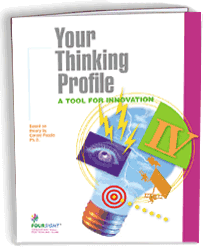Announcing a new Peregrine Panel Partnership with FourSight! (FourSightOnline.com)
 One of the things I learned the hard way in my career is that people think differently. It’s obvious but it’s overlooked by many innovation leaders, including me. When I was a manager at a software venture I was often frustrated at the lack of team. I tried motivation, tried cajolation (new word), tried yelling, discussion, more yelling, and had loads of trouble getting everyone on the same page. I attributed it to personality problems, insanity, and idiocy. It’s a wonder I ever got anything done. If only I had some understanding of the concept of creative thinking style. Note to self: call Alan Sugar.
One of the things I learned the hard way in my career is that people think differently. It’s obvious but it’s overlooked by many innovation leaders, including me. When I was a manager at a software venture I was often frustrated at the lack of team. I tried motivation, tried cajolation (new word), tried yelling, discussion, more yelling, and had loads of trouble getting everyone on the same page. I attributed it to personality problems, insanity, and idiocy. It’s a wonder I ever got anything done. If only I had some understanding of the concept of creative thinking style. Note to self: call Alan Sugar.
I became aware of creative thinking style through the work of Dr. Michael Kirton, who developed the Kirton Adaptor-Innovator Inventory (KAI assessment). Kirton put people on a simple scale from Adaptor (“better” thinkers) to Innovators (“different” thinkers). It was a revelation. I discovered I was a high Innovator, off the charts really (which goes some way towards explaining why I change jobs or careers about every four years). When one gets beyond a standard deviation on this scale, to two or three or more, you’re thinking Very Differently from those on the other side of the scale. You use the same language but you are coming from a completely different perspective. And that difference causes conflict, and lots of it. If you don’t understand creative thinking style putting together productive innovation teams is almost impossible. Awareness of thinking style is a fundamental building block for good innovation team communications. It’s also important to have thinking diversity on an innovation team. Kirton has documented that teams with diverse styles present come up with more innovative solutions.
I’m excited to announce a partnership for the Peregrine Panel with FourSightOnline.com. FourSight is a relatively new assessment that like the KAI measures creative thinking style. Unlike KAI, FourSight goes a step further, it measures a persons relative strengths and weaknesses across four main areas of creative problem solving. It measures your preferences for problem: Clarification, Idea Generation, Development, and Implementation. FourSight was developed by Gerard Puccio, PhD. I interviewed Gerard not so long ago with Innovise Guy partner Doug Stevenson. Listen to the podcast if you want a real detailed picture of the tool and it’s purposes. Doug and I also interviewed the person who is taking FourSight to market, Blair Miller. Blair is a good friend and now a business associate. I’ve always admired his pragmatic approach to innovation. Speaking of pragmatic, another excellent aspect of FourSight is it’s available online (the KAI is unfortunately, not). Peregrine Panelists will be taking the assessment in their PJ’s! Okay, it’s not a requirement!
From a Peregrine Panel point of view, FourSight offers a way to learn How panelists think. This is not typically done with market research panels and so it offers Peregrine a point of difference. It’s one thing to know demographics and lifestyle data about your panelists. It’s quite another to know how they think. Our panels can be created for customer projects that are aligned with the task at hand. You want ideas? A panel rich in folks with an Idea Generation preference makes sense. Trying to work out the specific words and positioning for a new product offering? Clarifiers are really good at that stuff. When a project requires diversity, we can provide not only ethnic, gender, and international diversity we can offer thinking diversity. For Innovation, thinking diversity might be the most important factor of all.
To review, Peregrine now has two partners, BrightIdea.com, for online WebStoming. And now, FourSightOnline.com for assessing panelists thinking styles. Be looking for more key partnerships in the weeks to come. This has only just begun.



3 responses to “Peregrine Partner: FourSight (Certainly Beats Hindsight!)”
[…] Here is the original post:Â Peregrine Partner: FourSight (Certainly Beats Hindsight!) […]
Hi Gregg,
Good work!
This topic of thinking style differences reminds me of the work of Kathy Kolbe in her test for Conative Index. Please check it out.
Her categories are:
Fact Finder
Implementor
Quick Start
Follow Through
People are usually resistant and specialized in varied mixtures of these strategies. Certain jobs take a particular mixture of these motivating strategies; if you match the person who naturally possesses these attributes with the job requirements – you will have no absenteeism!
Rarely, a person may be absolutely in the mid-range of all four. It is these kinds of people who tend to gravitate towards coordinating others, because it is almost as if they can translate between strategies.
Aloha – Fran Engel from the Big Island of HI
I would like to get further info.Thank you.